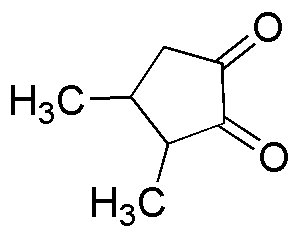3,4-Dimethyl-1,2-cyclopentadione is widely utilized in research focused on:
- Organic Synthesis: This compound serves as a versatile building block in organic chemistry, allowing researchers to create complex molecules efficiently. Its unique structure makes it valuable for synthesizing various derivatives.
- Pharmaceutical Development: It is used in the development of pharmaceutical compounds, particularly in creating new drugs with enhanced efficacy. Its ability to modify biological activity makes it a key player in medicinal chemistry.
- Material Science: The compound is employed in the formulation of advanced materials, such as polymers and coatings. Its properties contribute to improved durability and performance in various applications.
- Flavor and Fragrance Industry: 3,4-Dimethyl-1,2-cyclopentadione is utilized in creating specific flavors and fragrances, providing unique sensory attributes that enhance consumer products.
- Analytical Chemistry: It is used as a reagent in analytical methods, helping to identify and quantify other compounds in complex mixtures. This application is crucial for quality control in various industries.
General Information
Properties
Safety and Regulations
Applications
3,4-Dimethyl-1,2-cyclopentadione is widely utilized in research focused on:
- Organic Synthesis: This compound serves as a versatile building block in organic chemistry, allowing researchers to create complex molecules efficiently. Its unique structure makes it valuable for synthesizing various derivatives.
- Pharmaceutical Development: It is used in the development of pharmaceutical compounds, particularly in creating new drugs with enhanced efficacy. Its ability to modify biological activity makes it a key player in medicinal chemistry.
- Material Science: The compound is employed in the formulation of advanced materials, such as polymers and coatings. Its properties contribute to improved durability and performance in various applications.
- Flavor and Fragrance Industry: 3,4-Dimethyl-1,2-cyclopentadione is utilized in creating specific flavors and fragrances, providing unique sensory attributes that enhance consumer products.
- Analytical Chemistry: It is used as a reagent in analytical methods, helping to identify and quantify other compounds in complex mixtures. This application is crucial for quality control in various industries.
Documents
Safety Data Sheets (SDS)
The SDS provides comprehensive safety information on handling, storage, and disposal of the product.
Product Specification (PS)
The PS provides a comprehensive breakdown of the product’s properties, including chemical composition, physical state, purity, and storage requirements. It also details acceptable quality ranges and the product's intended applications.
Certificates of Analysis (COA)
Search for Certificates of Analysis (COA) by entering the products Lot Number. Lot and Batch Numbers can be found on a product’s label following the words ‘Lot’ or ‘Batch’.
*Catalog Number
*Lot Number
Certificates Of Origin (COO)
This COO confirms the country where the product was manufactured, and also details the materials and components used in it and whether it is derived from natural, synthetic, or other specific sources. This certificate may be required for customs, trade, and regulatory compliance.
*Catalog Number
*Lot Number
Safety Data Sheets (SDS)
The SDS provides comprehensive safety information on handling, storage, and disposal of the product.
DownloadProduct Specification (PS)
The PS provides a comprehensive breakdown of the product’s properties, including chemical composition, physical state, purity, and storage requirements. It also details acceptable quality ranges and the product's intended applications.
DownloadCertificates of Analysis (COA)
Search for Certificates of Analysis (COA) by entering the products Lot Number. Lot and Batch Numbers can be found on a product’s label following the words ‘Lot’ or ‘Batch’.
*Catalog Number
*Lot Number
Certificates Of Origin (COO)
This COO confirms the country where the product was manufactured, and also details the materials and components used in it and whether it is derived from natural, synthetic, or other specific sources. This certificate may be required for customs, trade, and regulatory compliance.


